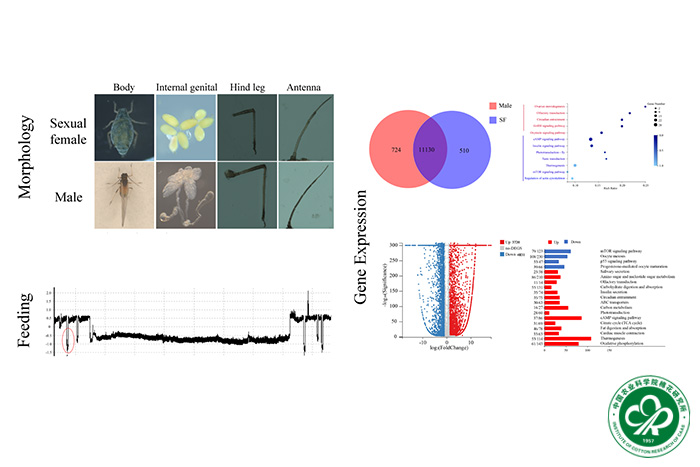- Location : Home» Newsroom
Systematically revealing sexual dimorphism of aphids at multiple levels firstly via model organism cotton aphid
Prof.Jinjie Cuigroup systematically revealed sexual dimorphism of aphids via model organism cotton aphidin the viewpoints of morphology, physiology, transcriptomics for the first time by usingtechniques or methods including microscopy, electron microscope scanning,EAG and RNA-seq.The results of this study has been published in Pest Management Science, a well-known journal of entomology science(Q1 inAgro-Forestry journals, ranking 9 in total 100Entomology journals).
Sexual dimorphism, referring to the phenomenon of distinct differences between male and female individuals in terms of individual size, body shape, body color, body structure, etc., in addition to the distinction of internal and external reproductive organs, exists widelyin animal and insects. The sexual dimorphism was well studied in numerous insects such as mosquitoes, mealybugs, beetles, crickets, butterflies, and cicada. In contract, in aphid species, related knowledge is rarely less due to their parthenogenesis in majority of the year.
In this study, male and female morphs of cotton aphid were obtained successfully according to the previously established protocol of sexual aphid induction, and then the biological comparison of two sexes was carried out. The results show that the male morphis exclusively alate with slender reddish yellow body and abdominal yellow-white stripes, whereas sexual female was exclusively apterous with a pudgy green body. The sensillum types of antennas is identical between the two sexes, whereas males have more sensilla number and wider distribution in filiform segments probably due to the significant longer antennae compared to sexual females. In feeding behavior, male takes more time to probe between mesophyll cells or phloem sieve and to salivate into phloem sieve. By contrast, sexual female spends more time in the ingestion of the xylem sap. Furthermore, 510 and 724 genes exclusively transcribed in sexual female or male separately were identified, which were dramatically enriched in signaling pathway related to reproduction for sexual female (i.e. ovarian steroidogenesis, GnRH signaling pathway, oxytocin signaling pathway), energy and flight for male (i.e. thermogenesis, insulin signaling pathway, regulation of actin cytoskeleton). Moreover, 8551 differentially expressed genes between the two sexes were identified as well, in which 3720 up-regulated genes in sexual female were mostly enriched into signaling pathways of metabolism and energy. Taken together, this study provides valuable resources for understanding sexual dimorphism of aphids hitherto and forms a basis to unfold the molecular mechanism underlying these differences between two sexes in cotton aphid.
The research was supported by the National Key Research and Development Program (2022YFD1400300) and the Agricultural Science and Technology Innovation Project of the Chinese Academy of Agricultural Sciences. Associate Professor Jichao Ji and Master Qingyu Shi are the co-first authors of the article. Professor Jinjie Cui and Junyu Luo, and assistant research fellow Li Wang are the corresponding authors. Link to the paper: https://doi.org/10.1002/ps.7718
